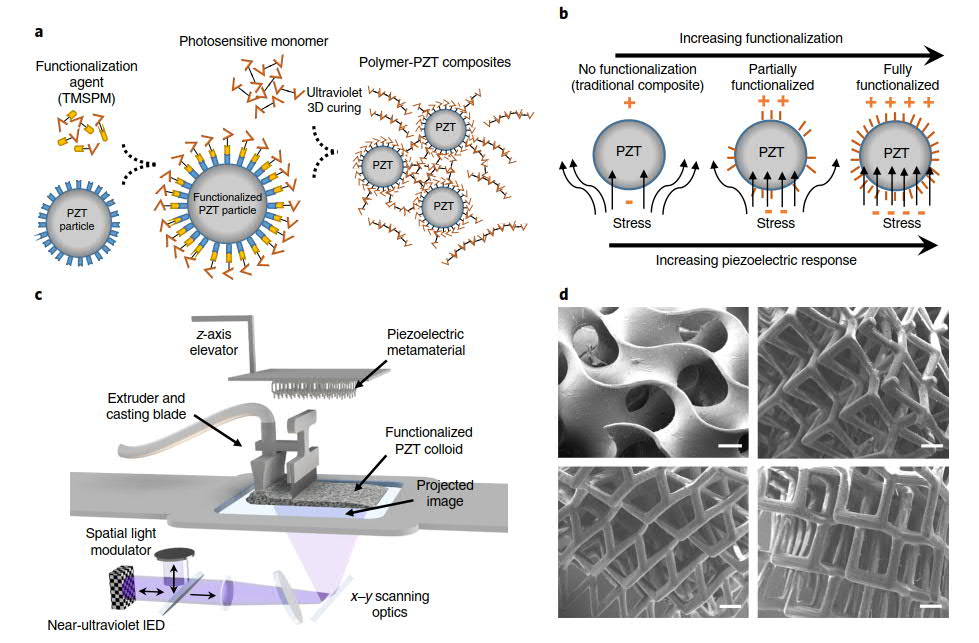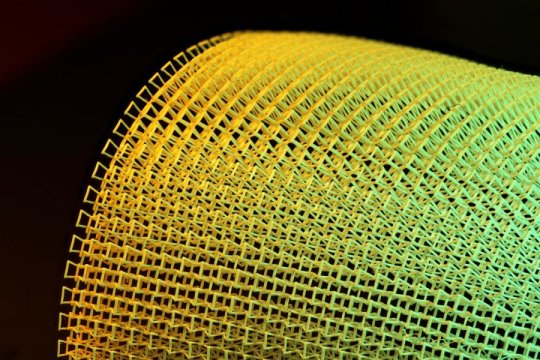Engineers from the Virginia Polytechnic Institute and State University (VT) have found a way to 3D print piezoelectric materials, which convert mechanical energy into electric current.
Xiaoyu ‘Rayne’ Zheng, Assistant Professor of Mechanical Engineering at VT and co-author of the research, explained, “By programming the 3D active topology, you can achieve pretty much any combination of piezoelectric coefficients within a material, and use them as transducers and sensors that are not only flexible and strong, but also respond to pressure, vibrations and impacts via electric signals that tell the location, magnitude and direction of the impacts within any location of these materials.”
“We have developed a design method and printing platform to freely design the sensitivity and operational modes of piezoelectric materials.”
Tapping electricity
Piezoelectric materials produce an electrical current when stress is applied. For example, if a piezoelectric film is connected to a small LED light, tapping the film (mechanical stress) with one’s finger will turn the LED on and off (electric current). This also works in the opposite direction i.e. when the electric current is applied to the piezoelectric film, it changes its shape up to 4%.
Piezoelectric materials can be found in nature such as the mineral quartz and topaz, and bones, or can be synthesized. Such materials have wide applications in sensor technology and can also be used as actuators in soft robotics.
One of the most popular applications of piezoelectric materials is in cigarette lighters, which ignite a flame when a spring hammer hits a piezoelectric crystal. More varied applications of these materials are also being explored, like the piezoelectric floor mat in a Japanese train station, used to produce electricity for the station.

3D printing piezoelectric ink
In the recent paper titled three-dimensional printing of piezoelectric materials with designed anisotropy and directional response, the researchers were able to make a 3D printable ink from lead zirconate titanate, a piezoelectric ceramic. This ink was then used to print various complex piezoelectric structures with a DLP printer.
Zheng explained, “We have synthesised a class of highly sensitive piezoelectric inks that can be sculpted into complex three-dimensional features with ultraviolet light. The inks contain highly concentrated piezoelectric nanocrystals bonded with UV-sensitive gels, which form a solution – a milky mixture like melted crystal – that we print with a high-resolution digital light 3D printer”

The sensor senses itself
Piezoelectric devices are generally made using conventional manufacturing techniques such as silicon mold processing and powder injection molding. Sometimes devices are made using piezoelectric films. However, these processes have limits on what shapes can be achieved. Whereas, 3D printing, in general, is capable of creating complex shapes (like lattice structures) with much greater ease than other manufacturing methods.
Now with the possibility of 3D printing piezoelectric materials “We can tailor the architecture to make them more flexible and use them, for instance, as energy harvesting devices, wrapping them around any arbitrary curvature” Zheng said.
Huachen Cui, a co-author of the research paper explained how having piezoelectric will simply future devices. Cui said: “Traditionally, if you wanted to monitor the internal strength of a structure, you would need to have a lot of individual sensors placed all over the structure, each with a number of leads and connectors”
“Here, the structure itself is the sensor – it can monitor itself.”
Control over the shape of piezoelectric materials also extends their sphere of applications.
Zheng added,“ We can make them thick, and light, stiff or energy-absorbing.”
“We have a team making them into wearable devices, like rings, insoles, and fitting them into a boxing glove where we will be able to record impact forces and monitor the health of the user.”
Furthermore, the team also discovered that some microstructures can convert energy more efficiently than others.

The research discussed in this article is titled “three-dimensional printing of piezoelectric materials with designed anisotropy and directional response” printed in the journal Nature Materials. It was co-authored by Huachen Cui, Ryan Hensleigh, Desheng Yao, Deepam Maurya, Prashant Kumar, Min Gyu Kang, Shashank Priya and Xiaoyu (Rayne) Zheng
Nominations for 3D Printing Industry Awards 2019 are open now. Visit the nominations page to name the academic team of the year.
For more news on the latest research in additive manufacturing subscribe to our 3D printing newsletter. You can also join us on Facebook and Twitter for live updates.
We also have great careers in 3D printing, see our 3D Printing Jobs board for more information and keep an eye on our jobs articles.
Featured image shows a 3D printed flexible sheet of piezoelectric material. Image via Virginia Tech.


